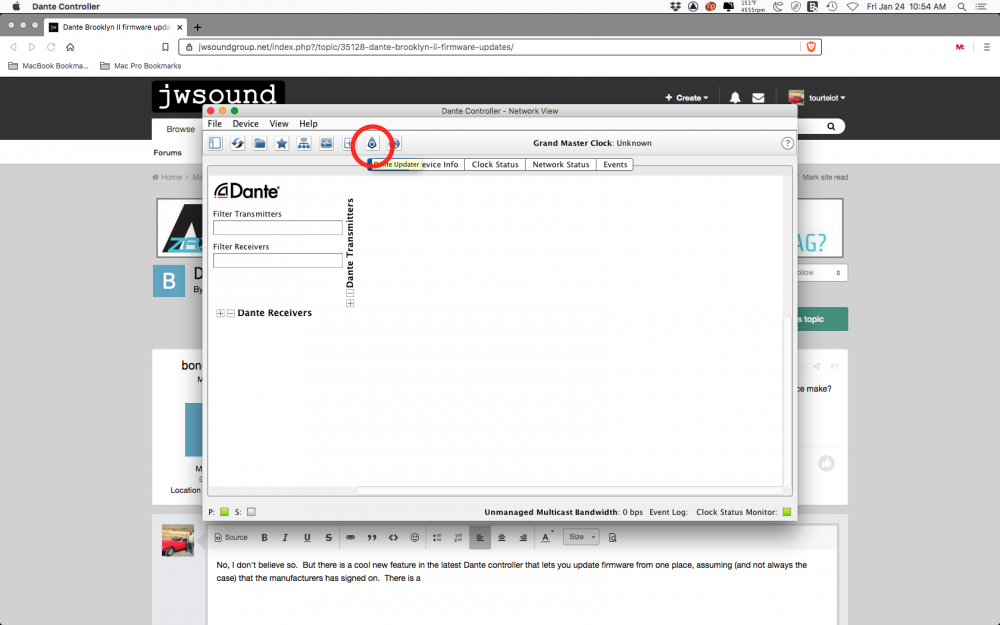-
Posts
1,111 -
Joined
-
Last visited
-
Days Won
52
Content Type
Forums
Gallery
Store
Everything posted by tourtelot
-
That's nice work! Way cooler than my dog collar D.
-

Fixing the Sennheiser HD25 connection problem
tourtelot replied to Vincent R.'s topic in Do It Yourself
Yep. Buy headphone that aren't so fussy. D. -
No, I don't believe so. I believe you get the update files from each separate manufacturer. But there is a cool new feature in the latest Dante controller that lets you update firmware from one place, assuming (and not always the case) that the manufacturers has signed on. There is a tab at the top. D.
-
I am a Reaper fan as well. For the price, you can not go wrong. Powerful, flexible, full featured, really inexpensive. A winner! D.
-
Oh wow Jan. This is SO large a can of worms that I can't do anything more than say "I will contribute" to this thread someday soon. I feels ya, and while I'm slightly beyond you, process-wise, there is a lot to chew on. Good luck and for those of you wondering how you'll know when it's time to get out. . . you will just know. D.
-
Pacific Radio in Burbank (?) if they have it in stock. https://www.pacrad.com/search/?q=Canare+L-4E5C D.
-

DIY TC cable (5pin LEMO to DIN 1.0/2.3) grounding question
tourtelot replied to mikebarber's topic in Do It Yourself
That assumes that chassis ground and electronic ground are strapped together. Sometimes that is true and sometimes the two grounds are not connected and if Pin 1 on the Lemo is not connected, the cable will not work. I would always connect Pin 1 on the low side but see no need to connect the low side (shield probably) to the Lemo shell. In fact, in some situations, that would open the path for a ground loop and increase the possibility for putting T/C audio into your primary audio path. D. -

DIY TC cable (5pin LEMO to DIN 1.0/2.3) grounding question
tourtelot replied to mikebarber's topic in Do It Yourself
And sorry, I thought the question involved attaching the shield to the connector shell. But you can't send any signal, balanced or not, on one wire. Pin 1 and Pin 5 on the Lemo to lo and hi on whatever connector feeds the Ultra Sync. Looks like an SMC? Gad, a different connector for TC. Ugh! Looks like the perfect application for my Camlock-to-SMC (TM) adapter. D. -

DIY TC cable (5pin LEMO to DIN 1.0/2.3) grounding question
tourtelot replied to mikebarber's topic in Do It Yourself
Un-necessary. No benefit and no need to make soldering those connectors any harder than they already are. D. -
I built a "boom box" once, double full sized with a 2" hole in the middle of the top and bottom. I built it out of 3/4" ply and it never got used. Too frickin' heavy. D.
-
Certainly consider these is you just want to try out the concept without spending a lot of cash. They punch well above their weight for the money. D.
-
Not exactly the answer to your question, but . . . My 788T. The only piece of audio gear I would never sell. D.
-
Sanken CS3e is a really great short shotgun. It even worked well indoors (well, not in the tile bathroom set); great reach and a nice sound. It is NOT the same tool that a Sennheiser MKH50 (also my favorite) and should not be compared. Might as well compare a TRAM to a U87. Different tools. D.
-
Sorry, I was away. Yes, absolutely. When I do that sort of breakout, I usually forego the 5-pin altogether and just strip back the jack 24" or so and use tech-flex on the exposed pair (exposed as in "not inside the outer jacket", not electrically exposed) and go right into 3-pin XLRs. Use heat shrink liberally. The Mogami individual pairs, especially, are thin and fragile. Fitting EXRs directly on the 2-pair is a bit tough but it can be done. No heat shrink on the 2-pair to 5-pin or the connector won't fit the increased thickness. Mogami 2-pair is very limber and easy to coil. The Canare is beefier but not as flexible. I use the Mogami now exclusively for any duplex but I have some Canare that is, wow, probably 35 years old and still works perfectly. I use the Belden when I need to stick more than a single pair into a connector. It is much easier to work with than struggling with putting connectors on 2-pair. Just the way I do it. I don't believe that I have 5-pins on anything that isn't for a stereo mic specifically. I have one stereo mic at this point. Almost all my duplex cables are just stripped back and terminated in 3-pin XLRs. But my way is not the only way of course. D.
-

David's new vintage sound kit... What's up with that? ;-)
tourtelot replied to Jim Feeley's topic in Equipment
I snorted coffee out of my nose! D. -

Gear Question for Recording Opera Tenor
tourtelot replied to ClassicalTenor's topic in General Discussion
Hmm, that's really not quite enough info to get the answer you are looking for but maybe I can get the discussion going. The room is small to expect a lot of (any?) "room" effect. If you sang in the room and I stood as far away as I could, I don't think I'd hear much room. Just your voice. As well, a cardioid mic will work hard to try and take away the room effect. That's what they are good at; no pickup from the rear where any room effect might be coming from. And that gets worse, the closer you work the mic. If you can get hold of a less directional mic, and I might go straight to a high quality omni, move it around the room until things get better. It might end up 6-10 feet away (the 1 meter rule says that acoustic sound should not be recorded with the mic closer than 1 meter, although that rule gets broken often, especially with spot mics, in modern classical music recording) depending on how loudly you sing, and then, of course, this invites the outside world in. Noise from outside the room will start to intrude. Compromises, ugh! You see those three tenor vids, all three on Schoeps Mk4 (maybe even Mk41s) but you need to remember, they are singing in ice hockey arenas with a full backing orchestra so isolation is imperative. That is not where/how you are singing. Compromises. Closer mic'ing with an omni will bring up articulation, farther (or is it further?) mic'ing will help with blend. Compromises. If you must work with the cardioid, you may decide to add a bit of some sort of outboard reverb just to take the curse off the room. Not a sin to do that; remember that you are trying to achieve an end. I have little doubt that there is plenty of artificial 'verb on the Three Tenors. Good luck, and feel free to PM me with specific questions or just continue the thread and others will chime in. There are a few acoustic recordist here. Many more on GearSlutz in the Remote Possibilities forum so you might ask over there as well. Good luck, but I am pretty sure that you will find a method that gets you close to what you want to sound like. Experimentation without preconceived notions is the key here. Try some stuff that you think wouldn't work and keep asking questions until you are (mostly) happy. D. -
I use Belden console wiring cable to make adapters like this. Easy to work with, 100% shielded and skinny. Good stuff. https://www.markertek.com/product/bl-1508a-500/belden-1508a-2-conductor-paired-microphone-cable-500-foot I also use nothing but Neutrik connetors for the most part. Some Switchcraft (RCA and some power coax) but the Neutrik connectors are really good. You can get them in nickel or gold plated, black or silve shells. I buy these at Parts Express. And the other cable I was talking about was Canare or Mogami two-pair. You can take a long length of this, say 100', put 5-pin XLRs on each end and make the adapters that you need to convert it back to two 2-pin XLRs (like the one above). Saves having to deploy and wrap two long regular mic-cables. Or just plug the female end right into the mic and only need to adapt the other end. Or build whatever system you like. https://www.redco.com/Mogami-W2930.html D.
-
Do you have 2-pair 5-pin cable already? Mogami or Canare terminated in 5-pin XLRs? Then it is only a matter of taking skinny mic cable (or Beldon console wire) and making two adapters, one 5-pin XLR to break out into two 3-pin XLR. Pin 1 on the 5-pin XLR goes to pin-1 on both 3-pin XLRs. It's a standard wiring scheme, but if you can't find it on the net, drop me a PM and I'll send you a sketch. D.
-
Okay. But no thoughts of that. Thanks. D.
-
Asking for a friend. If he had, lets say, a Lectro package in Block 29 and used it, literally, once or twice a year. . . . Once or twice a year in different locals for an hour or three. What is the collective thoughts about the real-world liability of such a plan? D.
-
The closest WHAT to an LDC? Let's put it up against a TLM-170 and see if anyone can hear the difference. Oh, and I am even a DPA fan; use their mics all the time. But, say what? SMH. D.
-
Two extra days to correct for a one frame off-set? Did I read that right? Someone has their hand in a lucrative cookie-jar if that is true. It's a set-it-and-forget-it in most every room I know of. D.
-
I just used empty white 5" 1/4" boxes that I got by the hundreds from somewhere. And yes, lots of sticky labels. Nothing worse than hear that a DAT tape was lost. Maybe (for a while) backed on a Nagra IVSTC; later a HHB mini-disk recorder. Ugh! D. And slightly OT, but labels were always important. I'd put them on the top of heads-out 7" raw rolls and if the tape wouldn't spool off the correct way with the label facing up, the roll was "exposed". I never, in all my years, recorded over any day's work. And I knew, personally, of some very big-league mixers who could not claim the same. Arrrrgh!

.png.279748a58a2b862b7aa5f3b84126e232.png)


